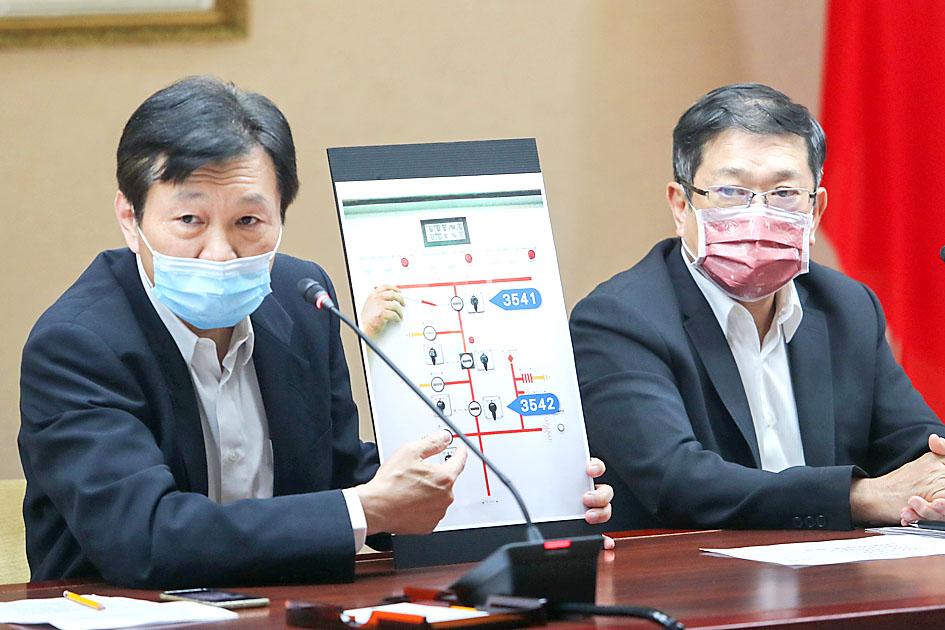Taiwan Power Co (Taipower, 台電) has enlisted independent power producers (IPPs) to help raise its reserve capacity to more than 6 percent, as the state-owned utility tries to avoid yet another round of blackouts across the nation.
There have already been two power outages over the past six days, with the first one causing five hours of rolling blackouts, amid record power consumption for the month of May.
“We do not usually see this kind of energy usage until July,” Taipower spokesman Chang Ting-shu (張廷舒) said.

Photo: CNA
Yesterday’s peak consumption was 37.57 gigawatts, breaking the all-time May record of 37.44 gigawatts set the day before.
To help Taipower improve its power supply status from “orange alert” (reserve capacity of less than 6 percent) to “yellow alert,” (reserve capacity between 6 and 10 percent), Taipower appealed to IPPs, or facilities that generate electricity using steam from a separate operation.
“We gave them a preferential price to coordinate their power production with us,” Chang said.
A typical IPP could be a petrochemical or textile factory that utilizes steam, a byproduct of manufacturing, to generate power.
While the power they supply might be small compared with overall power demand, they could make a difference between continuity of supply or a third blackout within a week, he said.
Taipower did not take this month’s early heat and Taiwan’s overall economic growth into account when estimating this summer’s power consumption, he said.
The utility estimated that peak summer power consumption would be 38.7 gigawatts, just 3.01 percent above yesterday’s peak.
“The economy has been much stronger than we expected. It is hard to predict what peak usage this summer is going to look like,” he said.
However, most of the power supply difficulty stems from large units currently undergoing maintenance or repair, he said, vowing that all of the utility’s major units would return to service by next month, bringing much-needed stability.
In a separate news release yesterday, the Bureau of Energy said that overall energy use in Taiwan jumped 7.4 percent year-on-year in the first quarter.
This reflects not just increase in electricity use, but gas for transportation and petrochemicals for industrial use, the bureau said.
Although this is a high number, it is not a historical anomaly, a bureau specialist said.
During the 1990s, when Taiwan experienced very high annual GDP growth, it triggered similarly high jumps in energy use, the specialist said.
“We are trying to decouple GDP growth from energy use,” the specialist said. “We hope that we can eventually moderate or even decrease energy use while our economy continues to grow.”

China’s Huawei Technologies Co (華為) plans to start mass-producing its most advanced artificial intelligence (AI) chip in the first quarter of next year, even as it struggles to make enough chips due to US restrictions, two people familiar with the matter said. The telecoms conglomerate has sent samples of the Ascend 910C — its newest chip, meant to rival those made by US chipmaker Nvidia Corp — to some technology firms and started taking orders, the sources told Reuters. The 910C is being made by top Chinese contract chipmaker Semiconductor Manufacturing International Corp (SMIC, 中芯) on its N+2 process, but a lack

NVIDIA PLATFORM: Hon Hai’s Mexican facility is to begin production early next year and a Taiwan site is to enter production next month, Nvidia wrote on its blog Hon Hai Precision Industry Co (鴻海精密), the world’s biggest electronics manufacturer, yesterday said it is expanding production capacity of artificial intelligence (AI) servers based on Nvidia Corp’s Blackwell chips in Taiwan, the US and Mexico to cope with rising demand. Hon Hai’s new AI-enabled factories are to use Nvidia’s Omnivores platform to create 3D digital twins to plan and simulate automated production lines at a factory in Hsinchu, the company said in a statement. Nvidia’s Omnivores platform is for developing industrial AI simulation applications and helps bring facilities online faster. Hon Hai’s Mexican facility is to begin production early next year and the

AVIATION BOOM: CAL is to renew its passenger and cargo fleets starting next year on record profits as aviation continues to return to pre-pandemic levels China Airlines Ltd (CAL, 中華航空) yesterday said it is optimistic about next year’s business outlook, as the airline continues to renew its fleet on expectations that global passenger traffic would maintain steady growth and air cargo demand would remain strong. From next year to 2028, the airline is to welcome a new Boeing Co 787 fleet — 18 787-9 and six 787-10 passenger aircraft — to cover regional and medium to long-haul destinations, CAL chairman Hsieh Shih-chien (謝世謙) said at an investors’ conference in Taipei. The airline would also continue to introduce Airbus SE 321neo passenger planes and Boeing 777F cargo jets,

Who would not want a social media audience that grows without new content? During the three years she paused production of her short do-it-yourself (DIY) farmer’s lifestyle videos, Chinese vlogger Li Ziqi (李子柒), 34, has seen her YouTube subscribers increase to 20.2 million from about 14 million. While YouTube is banned in China, her fan base there — although not the size of YouTube’s MrBeast, who has 330 million subscribers — is close to 100 million across the country’s social media platforms Douyin (抖音), Sina Weibo (新浪微博) and Xiaohongshu (小紅書). When Li finally released new videos last week — ending what has